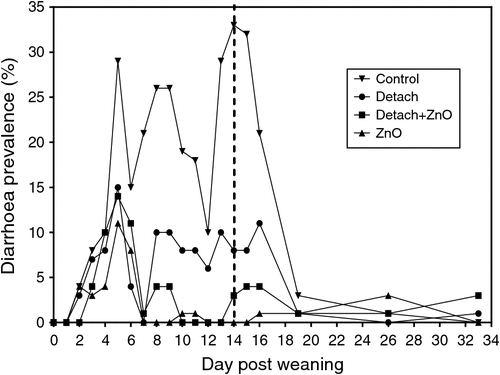A comparative study of the efficacy of Detach® versus zinc oxide to control post-weaning diarrhoea in pigs
P. K. Holyoake A C and T. L. Mynott BA Holyoake Veterinary Consulting, Strathfieldsaye, VIC 3551.
B Anatara Lifesciences, Brisbane, QLD 4210.
C Corresponding author. Email: trishpigvet@bigpond.com
Animal Production Science 57(12) 2503-2503 https://doi.org/10.1071/ANv57n12Ab019
Published: 20 November 2017
Diarrhoea is a major cause of ill-thrift and mortality in piglets post-weaning. Control strategies include improved hygiene, antibiotics and high concentrations of in-feed zinc oxide (ZnO). There are increasing concerns regarding the use of antibiotics and ZnO because of the potential for developing bacterial resistance, hence the need for non-antimicrobial alternatives to control diarrhoea. Detach® (Antara Lifesciences Ltd, Brisbane, Qld, Australia), comprised of bromelain, a proteolytic extract from pineapple stems, is one alternative as it has been shown to reduce diarrhoea in piglets through its anti-attachment and anti-secretory effects in the intestine (Chandler and Mynott 1998; Mynott et al. 1997). The objective of this study was to compare the efficacy of Detach® to ZnO in-feed treatment in a Spanish herd with a history of post-weaning diarrhoea due to Escherichia coli. Healthy, 25-day-old pigs were ear tagged and randomly assigned at weaning (d 0) to one of four groups (72 piglets per group): (1) Detach®; (2) Detach®+ZnO; (3) ZnO; or (4) nil treatment. Pigs in Groups 1 and 2 received a single 4 mL drench of Detach® on d 0, whilst 2500 ppm ZnO (Apsamix Zinc, Andres Pintaluba S.A., Reus, Spain) was included in the diet of pigs in Groups 2 and 3 from d 0 to 14. All pigs received a diet containing 2500 ppm ZnO from d 15 to 42, as per the standard practice on this farm. Pigs were housed in 48 pens (six piglets per pen) in two identical nursery rooms. Each pig was examined from d 2 to 16 and on d 19, 26, 33 and 42 and scored for faecal consistency (normal (0), pasty/semi-liquid (1) or liquid/watery (2) and clinical condition (0 = normal, 1 = depressed). The combined faecal and clinical scores were used to categorise pigs as morbid/sick (Score 2/3) or healthy (Score 0/1). The number of sick days per pen was analysed using a linear mixed model with room/gender as random effects and treatment as the fixed effect (Genstat for Windows, 2007). The number of pigs with diarrhoea per pen was analysed pairwise as binomial data using Binomial Logistic Regression (LogXact v8.0, Cytel, Cambridge, MA, USA).
Over the d 0 to 14 and 0 to 42 post-weaning period, Detach® and ZnO were equally effective at reducing diarrhoea compared to controls (P < 0.05) (Fig. 1). Detach® and ZnO-treatment groups had fewer sick days (P < 0.05) and less antibiotic treatments than controls (P < 0.05), with 15, 0, 2 and 33 treatments administered to the Detach®, Detach®+ZnO, ZnO and control groups, respectively. Weight gains from d 0 to 14 were Detach® 0.7 kg, Detach®+ZnO 1.14 kg, ZnO 1.03 kg and control 0.57 kg, with ZnO-treated pigs gaining more weight than the other groups (P < 0.05). Neither treatment had a significant effect on weight gain between d 0 to 42; Detach 12.4 kg, Detach®+ZnO 12.5 kg, ZnO 12.6 kg and control 12.2 kg.

|
Under the conditions of this study, a single dose of Detach® at weaning was as effective as in-feed ZnO in reducing the prevalence of diarrhoea and antibiotic treatments post-weaning compared to untreated pigs.
References
Chandler DS, Mynott TL (1998) Gut 43, 196–202.| Crossref | GoogleScholarGoogle Scholar |
Mynott TL, Guandalini S, Raimondi F, Fasano A (1997) Gastroenterology 113, 175–184.
| Crossref | GoogleScholarGoogle Scholar |
Leigh Callinan for statistical analysis. Guillermo Cano and Javier Cancho of Tests and Trials, Huesca, Spain for performing the study.


